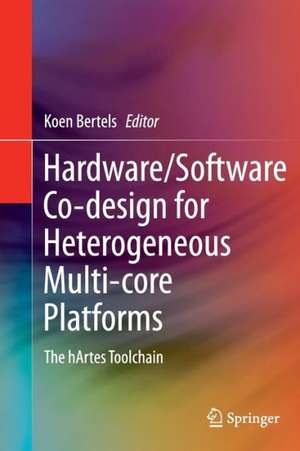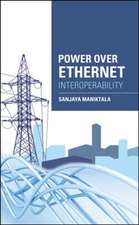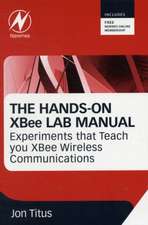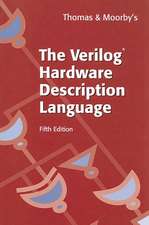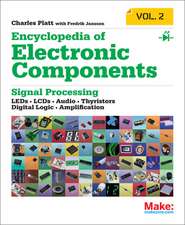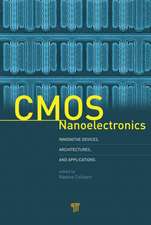Hardware/Software Co-design for Heterogeneous Multi-core Platforms: The hArtes Toolchain
Editat de Koen Bertelsen Limba Engleză Paperback – 26 ian 2014
| Toate formatele și edițiile | Preț | Express |
|---|---|---|
| Paperback (1) | 557.21 lei 38-44 zile | |
| SPRINGER NETHERLANDS – 26 ian 2014 | 557.21 lei 38-44 zile | |
| Hardback (1) | 642.51 lei 6-8 săpt. | |
| SPRINGER NETHERLANDS – 6 noi 2011 | 642.51 lei 6-8 săpt. |
Preț: 557.21 lei
Preț vechi: 696.52 lei
-20% Nou
Puncte Express: 836
Preț estimativ în valută:
106.63€ • 115.79$ • 89.57£
106.63€ • 115.79$ • 89.57£
Carte tipărită la comandă
Livrare economică 18-24 aprilie
Preluare comenzi: 021 569.72.76
Specificații
ISBN-13: 9789400797192
ISBN-10: 9400797192
Pagini: 256
Ilustrații: XXII, 234 p.
Dimensiuni: 155 x 235 x 13 mm
Greutate: 0.36 kg
Ediția:2012
Editura: SPRINGER NETHERLANDS
Colecția Springer
Locul publicării:Dordrecht, Netherlands
ISBN-10: 9400797192
Pagini: 256
Ilustrații: XXII, 234 p.
Dimensiuni: 155 x 235 x 13 mm
Greutate: 0.36 kg
Ediția:2012
Editura: SPRINGER NETHERLANDS
Colecția Springer
Locul publicării:Dordrecht, Netherlands
Public țintă
Professional/practitionerCuprins
Introduction.- ThArtes Toolchain.- The hArtes Platform.- Audio Array Processing for Telepresence.- In Car Audio.- Extensions of the hArtes Toolchain.- Conclusion: Multi-Core Processor Architectures are Here to Stay.
Recenzii
From the reviews:
“Professionals striving to work on both software and hardware will appreciate this book. C/C++ developers involved in programming for heterogeneous embedded systems will also benefit from the book’s broad overview, ranging from design problems to a fully automated approach. The book presents a hardware/software (HW/SW) abstraction in the form of the hArtes toolchain, supporting application-level mapping and profiling to provide an interesting advantage for dealing with heterogeneous platforms. … this is a great book.” (Andre Maximo, ACM Computing Reviews, June, 2012)
“Professionals striving to work on both software and hardware will appreciate this book. C/C++ developers involved in programming for heterogeneous embedded systems will also benefit from the book’s broad overview, ranging from design problems to a fully automated approach. The book presents a hardware/software (HW/SW) abstraction in the form of the hArtes toolchain, supporting application-level mapping and profiling to provide an interesting advantage for dealing with heterogeneous platforms. … this is a great book.” (Andre Maximo, ACM Computing Reviews, June, 2012)
Textul de pe ultima copertă
This book describes the results and outcome of the FP6 project, known as hArtes, which focuses on the development of an integrated tool chain targeting a heterogeneous multi core platform comprising of a general purpose processor (ARM or powerPC), a DSP (the diopsis) and an FPGA. The tool chain takes existing source code and proposes transformations and mappings such that legacy code can easily be ported to a modern, multi-core platform.
Benefits of the hArtes approach, described in this book, include:
Benefits of the hArtes approach, described in this book, include:
- Uses a familiar programming paradigm: hArtes proposes a familiar programming paradigm which is compatible with the widely used programming practice, irrespective of the target platform.
- Enables users to view multiple cores as a single processor: the hArtes approach abstracts away the heterogeneity as well as the multi-core aspect of the underlying hardware so the developer can view the platform as consisting of a single, general purpose processor.
- Facilitates easy porting of existing applications: hArtes provides a migration path where either through manual annotation or the use of the tool chain to apply the necessary modifications, one can test on the real platform how the application behaves and, when necessary, repeat the process if the design objective has not been met.
- Enables development of new applications using powerful toolboxes: the hArtes tool chain provides both high level algorithm exploration tools with subsequent, automatic code generation which can then be fed to other toolboxes in the chain.
- Employs an open tool chain architecture: any development tool can be integrated in the tool chain, so users are not locked into a single vendor technology.
- Allows users easily to retarget to new hardware platforms: the same development tools and environments can be used, no matter what hardware platform one targets.
- Maps from fully automatic to fully manual: developers can choose to opt fora full automatic mapping, semi-automatic or even fully manual. At each step, decisions can be evaluated and overruled if considered inadequate.
Caracteristici
Book addresses a big challenge in the ES industry which is to port applications to multi-core platforms Detailed description of operational tool chain Simulation examples downloadable from internet Includes supplementary material: sn.pub/extras
